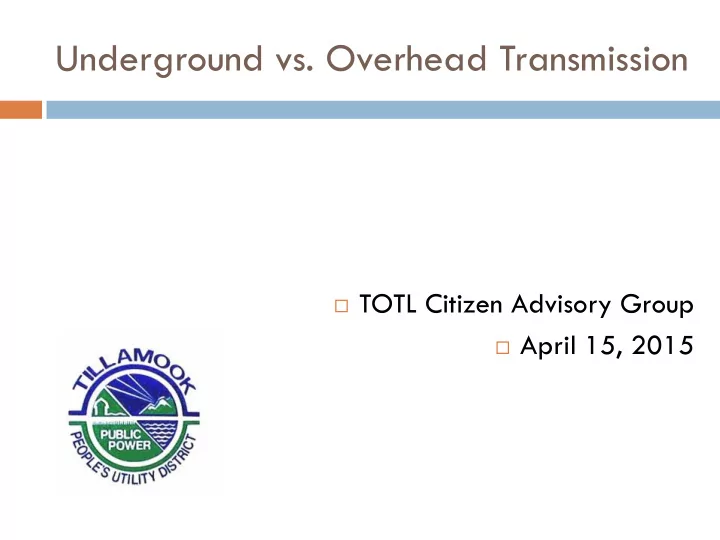

Underground vs. Overhead Transmission TOTL Citizen Advisory Group April 15, 2015
Transmission and Distribution Transmission System Distribution System Transmission lines Distributes electricity connect power to each customer's generation plants to residence, business, or substations, other industrial plant at power generating lower voltages. plants, and other utilities at high voltages.
Transmission and Distribution Transmission Distribution
Underground and Overhead Transmission Distribution Undergrounding Undergrounding transmission lines is less distributions lines is common more common Underground cables have different technical requirements than overhead and have different impacts
Impacts Design Construction Repair and Maintenance Cost Aesthetics
Underground vs. Overhead Transmission Design Issues Specialized engineering skills required Extensive study required to determine site-specific subsurface obstructions or obstacles Longer timeframe for design Need to provide larger budget contingency Flood plain and wetland issues require special consideration Environmental impacts
Underground vs. Overhead Transmission Construction Concerns Space for large vaults (8’ x 10’ X 20’) Longer construction time frame Dewatering in wet areas during construction Significantly more impacts to surrounding properties Open trenches min. 5’ wide x 5’ deep Specialized backfill
Underground vs. Overhead Transmission Operational Concerns Difficult to identify outage location Requires specialized work force Long lead time for delivery of materials Need to warehouse specialized spare materials Increased maintenance Shorter life span Dewatering and cleaning of equipment in vaults
Underground vs. Overhead Transmission Cost Typical underground costs are 8 to 10 times the cost of overhead construction Typical life of underground is approximately one-half the life of overhead construction Depending on route may have significantly more unanticipated problems with associated costs 4-Cable system required to increase reliability which adds cost Specialized workforce increases cost Wetland mitigation may be substantially more depending on route Warehousing of spare materials and equipment
Underground Transmission Generally used: in densely populated and urban settings where sufficient right-of-way is not available to reduce visual impacts riser poles at each end of the underground cable are large and support additional equipment that create visual impacts Reliability May have fewer outages than overhead When outages occur they will be more difficult to locate and may take significantly more time to repair
Recommend
More recommend